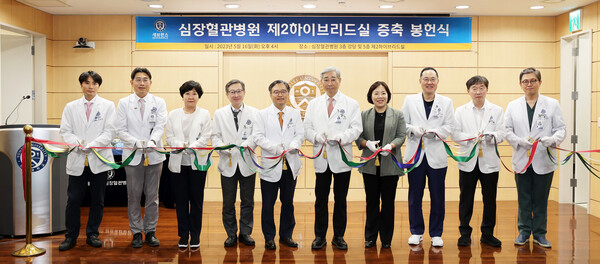Severance Hospital said that it opened the Aortic Center at Severance Cardiovascular Hospital on May 16 to enhance emergency treatment for patients with aortic disease.

The newly opened aortic center boasts an improved workflow system for quick treatment. Previously, patients with aortic diseases had to wait for acceptance from the cardiovascular surgeon after the referring hospital contacted the emergency department coordinator who then consults with the surgeon.
At the Aortic Center, the referral call is answered directly by a cardiovascular surgeon thus streamlining the referral process and reducing the time to treatment as much as possible.
Under the new system, patients will now go directly to the intensive care unit (ICU) at Severance Cardiovascular Hospital instead of the emergency room (ER), where they can be transferred to the operating room for surgeries and procedures.
In addition to emergency patients, the hospital also has a system for fast-tracking outpatients. The Aortic Center is a one-stop shop for cardiology and cardiovascular surgery outpatient care. For example, if a patient is at risk for an aortic rupture in the morning outpatient clinic, he or she can be seen in the afternoon for surgery, alleviating patients’ concerns about aorta ruptures.
As aortic disease care involves faculty from cardiovascular surgery and cardiology, as well as radiology, anesthesiology, and pain medicine, the hospital’s multidisciplinary approach ensures the best possible care.
When the blood vessel walls weaken due to aging or disease, they can stretch or tear. Two common conditions are aortic aneurysms, in which the aorta stretches like a balloon and can burst, and aortic dissections, in which the inner walls of the blood vessel tear. Both conditions are emergencies that require fast treatment.
Additionally, failure to maintain blood pressure in acute aortic diseases can lead to shock, unconsciousness, and even death. If the blood flow is interrupted renal and hepatic failure and leg necrosis can occur and the consequences can be severe if not treated in time. Extreme pain in the chest also requires immediate medical attention which can be sought through calling 119.
Surgery to cut out the damaged aorta and replace it with an artificial vessel is the basic treatment. Depending on the patient's condition, a stent may also be inserted into the aorta.
"When acute aortic disease occurs, if treatment is not performed within the golden time of 1 to 24 hours, the patient can die," said Joo Hyun-chel, director of the Aortic Center of Severance Cardiovascular Hospital. "To save every second of the golden time, our center has a professor of cardiovascular surgery on call to ensure the best possible treatment for patients."
Meanwhile, Severance Hospital also opened a second hybrid operating room (OR) at Severance Cardiovascular Hospital on the same day, having opened the first in 2011. Hybrid ORs allow for operating rooms to be immediately converted to surgery in the case of an emergency during a procedure so the patient does not need to be moved to another OR for a last-minute surgery.
It also allows for greater synergy between surgeries and other medical procedures. For example, in blood-intensive surgeries, a procedure to close blood vessels can be performed before surgery, which not only reduces the patient's burden but also reduces the difficulty of surgery for high-risk patients and lowers the rate of complications.
Related articles
- Severance Hospital develops personalized maternity care platform
- YUHS claims top spot in local survey for digital customer satisfaction
- Korea’s 1st heavy particle therapy performed on prostate cancer patient
- Korean health industry rushes to offer relief support to quake-struck Turkey, Syria
- Vitamin D deficiency surged in Koreans. Is this overcalculated?
- Iron Child event inspires hope in pediatric heart failure patients
- Patient with 10 times normal liver weight gets successful transplant at Severance
- Severance introduces smart bed management system for efficient room occupancy
- Patient with multiple heart surgeries thrives after successful heart transplant at Severance
- SGLT-2 inhibitor diabetes drug proves effective in alleviating NASH symptoms: study

